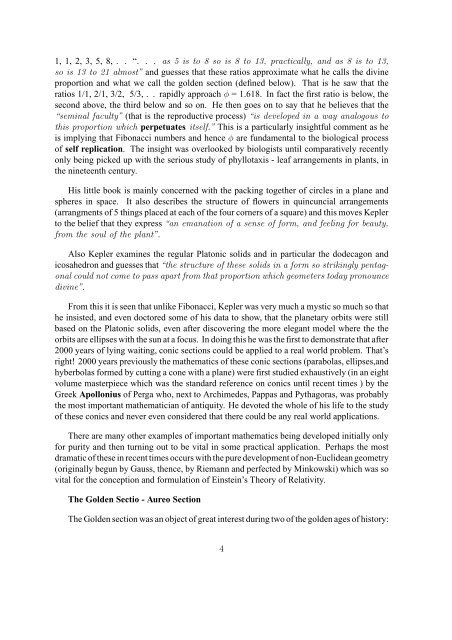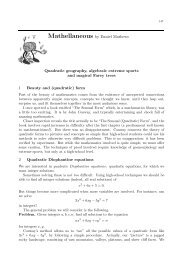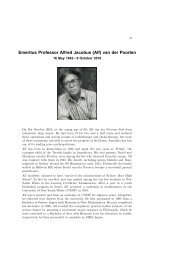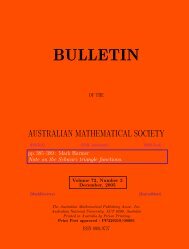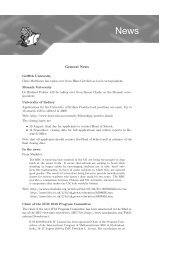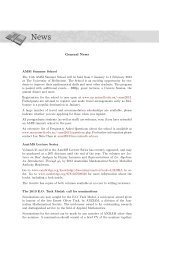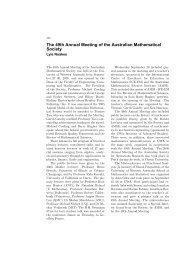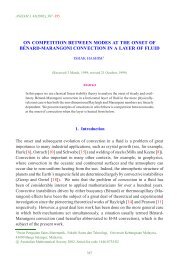FIBONACCI - HIS RABBITS AND HIS NUMBERS and KEPLER
FIBONACCI - HIS RABBITS AND HIS NUMBERS and KEPLER
FIBONACCI - HIS RABBITS AND HIS NUMBERS and KEPLER
Create successful ePaper yourself
Turn your PDF publications into a flip-book with our unique Google optimized e-Paper software.
1, 1, 2, 3, 5, 8, . . “. . . as 5 is to 8 so is 8 to 13, practically, <strong>and</strong> as 8 is to 13,<br />
so is 13 to 21 almost” <strong>and</strong> guesses that these ratios approximate what he calls the divine<br />
proportion <strong>and</strong> what we call the golden section (defined below). That is he saw that the<br />
ratios 1/1, 2/1, 3/2, 5/3, . . rapidly approach φ = 1.618. In fact the first ratio is below, the<br />
second above, the third below <strong>and</strong> so on. He then goes on to say that he believes that the<br />
“seminal faculty” (that is the reproductive process) “is developed in a way analogous to<br />
this proportion which perpetuates itself.” This is a particularly insightful comment as he<br />
is implying that Fibonacci numbers <strong>and</strong> hence φ are fundamental to the biological process<br />
of self replication. The insight was overlooked by biologists until comparatively recently<br />
only being picked up with the serious study of phyllotaxis - leaf arrangements in plants, in<br />
the nineteenth century.<br />
His little book is mainly concerned with the packing together of circles in a plane <strong>and</strong><br />
spheres in space. It also describes the structure of flowers in quincuncial arrangements<br />
(arrangments of 5 things placed at each of the four corners of a square) <strong>and</strong> this moves Kepler<br />
to the belief that they express “an emanation of a sense of form, <strong>and</strong> feeling for beauty,<br />
from the soul of the plant”.<br />
Also Kepler examines the regular Platonic solids <strong>and</strong> in particular the dodecagon <strong>and</strong><br />
icosahedron <strong>and</strong> guesses that “the structure of these solids in a form so strikingly pentagonal<br />
could not come to pass apart from that proportion which geometers today pronounce<br />
divine”.<br />
From this it is seen that unlike Fibonacci, Kepler was very much a mystic so much so that<br />
he insisted, <strong>and</strong> even doctored some of his data to show, that the planetary orbits were still<br />
based on the Platonic solids, even after discovering the more elegant model where the the<br />
orbits are ellipses with the sun at a focus. In doing this he was the first to demonstrate that after<br />
2000 years of lying waiting, conic sections could be applied to a real world problem. That’s<br />
right! 2000 years previously the mathematics of these conic sections (parabolas, ellipses,<strong>and</strong><br />
hyberbolas formed by cutting a cone with a plane) were first studied exhaustively (in an eight<br />
volume masterpiece which was the st<strong>and</strong>ard reference on conics until recent times ) by the<br />
Greek Apollonius of Perga who, next to Archimedes, Pappas <strong>and</strong> Pythagoras, was probably<br />
the most important mathematician of antiquity. He devoted the whole of his life to the study<br />
of these conics <strong>and</strong> never even considered that there could be any real world applications.<br />
There are many other examples of important mathematics being developed initially only<br />
for purity <strong>and</strong> then turning out to be vital in some practical application. Perhaps the most<br />
dramatic of these in recent times occurs with the pure development of non-Euclidean geometry<br />
(originally begun by Gauss, thence, by Riemann <strong>and</strong> perfected by Minkowski) which was so<br />
vital for the conception <strong>and</strong> formulation of Einstein’s Theory of Relativity.<br />
The Golden Sectio - Aureo Section<br />
The Golden section was an object of great interest during two of the golden ages of history:<br />
4


